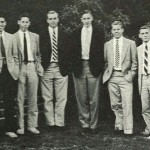
Back in the heyday of the Ivy League Look, when a boy was going steady he’d remove the locker loop on the back of his oxford-cloth buttondown, signalling to other females that he was spoken for.
And how did a female student signal she was taken? By wearing her boyfriend’s college scarf. The practice was especially popular at the two schools that most set the style in campus fashion: Princeton and Vassar.
Observing the trend from New Haven, the Yale Daily News noted in 1959 that Vassar was a sea of scarf wearers, writing, “Alarmingly enough, orange and black specimens are almost as prevalent as blue and white. As one girl explained, ‘After all, Princeton boys are desperate to give away scarves.'”
There’s no doubt that the ultimate accessory for any bermuda short and Brooks Brothers-clad Vassar girl was a men’s college scarf, a fashion trend echoed throughout the Seven Sisters community as polo coats and “college mufflers” became big business.
To those beyond the Ivy gates, the clothes of the quintessential Vassar student could be seen as a sign of belonging to the academic elite of the Seven Sisters colleges. But individual garments could also reveal status between the students themselves, and the significance given to a man’s scarf when worn on the campus of a woman’s college is a perfect example.
“The most fashionable girls had a long wool scarf from a men’s college,” remembers a Vassar graduate from the class of ’59. “These conveyed to other students that the wearer had a serious boyfriend at one of these prestigious campuses. However, a young woman might actually have bought it for herself.”
Indeed, such a student would never have admitted this fact: With the scarf, she now appeared to be not only effortlessly stylish, but involved with a guy from the Ivy League.
But it was not always boyfriends who gave this ultimate gift of status. Although they were the preferred benefactors, fathers and brothers often bought their female relatives a scarf from their college. “When my brother was a freshman at Yale, he gave me a Yale scarf for Christmas,” a Vassar ’56 graduate recalls. “Do you have any idea of the tremendous status that gave me as a lowly freshman?” And while the school’s prestige may have been just as high, these fraternal scarves probably didn’t have quite the same sentimental value as the ones gifted in romance.
In the end it didn’t matter whether the scarf was expertly draped across a cashmere twinset on a fall evening, tied tightly around the neck above a camelhair coat in the bitter Poughkeepsie winter, or even thrown over the shoulder on a weekend exodus to a neighboring men’s college: The men’s scarf indicated inclusion in the Seven Sisters-Ancient Eight student culture, and that you were, as Mary McCarthy would say, part of “The Group.” — REBECCA C. TUITE
Image from Vogue, 1954.










It’s nice to get the female side of the Ivy style into the perspective! Thanks for a nice article. I feel like it’s not as easy for girls to go classic prep today as it is for guys so it’s nice to get some pointers and a bit of background 🙂
The guy looks very much like James Franco
Oh, that’s just DARLING.
That guy in the photo? It looks like his eyebrows are about a week from pupation.
Today, at my campus, every girl wants to be “lavaliered” so she can wear her boyfriend’s fraternity letters. It’s definitely a status booster to be wearing a lavalier around your neck. I like the collegiate scarf, though. I’m also a fan of the collegiate necktie or skinny tie!
What’s the present-day equivalent?
Penny, On my campus (Indiana Univ.) half a century ago, a lavaliere meant engaged to be pinned. Generally, they were used by pledges who didn’t have a pin yet.
@Uncle
Update Facebook relationship status together.
“What’s the present-day equivalent?”
It’s one of the various STDs or maybe a mattress to carry around to classes. 😉